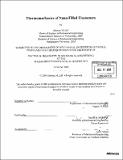Thermomechanics of nano-filled elastomers
Author(s)
Liff, Shawna M. (Shawna Marie)
DownloadFull printable version (44.43Mb)
Other Contributors
Massachusetts Institute of Technology. Dept. of Mechanical Engineering.
Advisor
Gareth H. McKinley.
Terms of use
Metadata
Show full item recordAbstract
The incorporation of nanoparticles into engineering thermoplastic elastomers affords engineers an opportunity to formulate flexible, tough and multifunctional polymer nanocomposites that potentially rival the most advanced materials in nature. Development of these materials is difficult since thermodynamic and kinetic barriers inhibit the dispersal of inorganic, hydrophilic nanoparticles into inherently hydrophobic polymer matrices. Thermoplastic polyurethanes (TPUs) are particularly attractive nanocomposite matrix materials due to their vast range of potential applications (e.g. in artificial organs, coatings, foams, and active wear), their mechanical versatility, and tunable block-polymeric structure. In this thesis we explore methods for systematically nanoreinforcing such materials by exploiting the microphase structure, differential polarities and multiple thermomechanical phase transitions of the macromolecular blocks that constitute the elastomeric matrix. Using a solvent exchange technique we show that it is possible to preferentially nanoreinforce the hard micro-domains of thermoplastic elastomers with smectic clay nanofillers that have characteristic dimensions similar to the hard segment. The adhesion between the clay and the hard micro-domains coupled with the formation of a percolative network not only stiffens and toughens, but increases the heat distortion temperature (HDT) of the material. The discotic clay platelets induce morphological ordering over a range of length scales that results in significant thermomechanical enhancement and expands high temperature applications. This thesis seeks to further enhance the understanding and utility of thermoplastic polyurethane nanocomposites by answering two questions: (1) what thermo-physical interactions between nano-clay and elastomeric thermoplastic polyurethane are taking place? and (2) how can these thermo-physical interactions be exploited? (cont.) To answer these questions the nano-reinforced-hard micro-domain morphology was monitored during deformation using in-situ wide angle x-ray scattering and combined with the results of extensive quasi-static mechanical testing which enabled the identification two characteristic relaxation times. A one-dimensional constitutive model to account for such morphological changes augmenting the previous model for unfilled polyurethanes developed by Qi and Boyce (2005) is discussed. Finally, the thermo-mechanical influence of nano-clay fillers on the shape memory effects exhibited by polyurethane nanocomposites is examined and multi-responsive shape memory polyurethane fibrous mats are developed via electrospinning. Quantifying and controlling the thermo-physical interactions between a block-copolymer with polar segments (e.g. thermoplastic polyurethane) and inorganic nanoparticles (e.g. nano-clay) is important for future nanocomposite processing strategies: the efficacy of nanoreinforcement hinges upon the close matching of characteristic length scale and the adhesion of the nanoparticles to the targeted polymer phase morphology. Exploiting the different polarity of the blocks in conjunction with solvent exchange approach developed in this thesis and solution processing techniques such as electro-spinning, offers an avenue toward the development of high performance, hierarchically-ordered materials that rival natural materials.
Description
Thesis (Ph. D.)--Massachusetts Institute of Technology, Dept. of Mechanical Engineering, 2008. Includes bibliographical references.
Date issued
2008Department
Massachusetts Institute of Technology. Department of Mechanical EngineeringPublisher
Massachusetts Institute of Technology
Keywords
Mechanical Engineering.